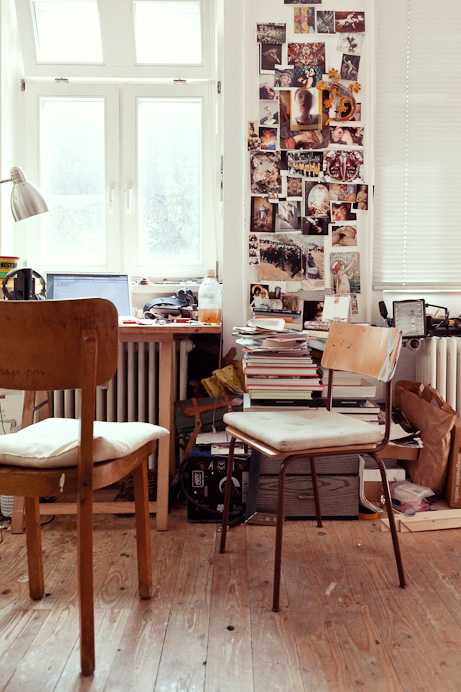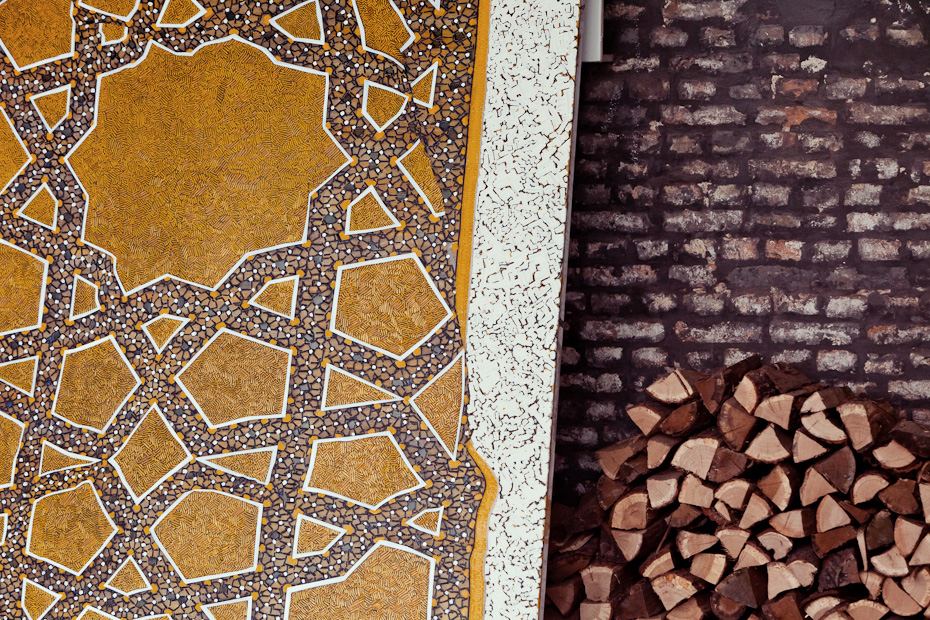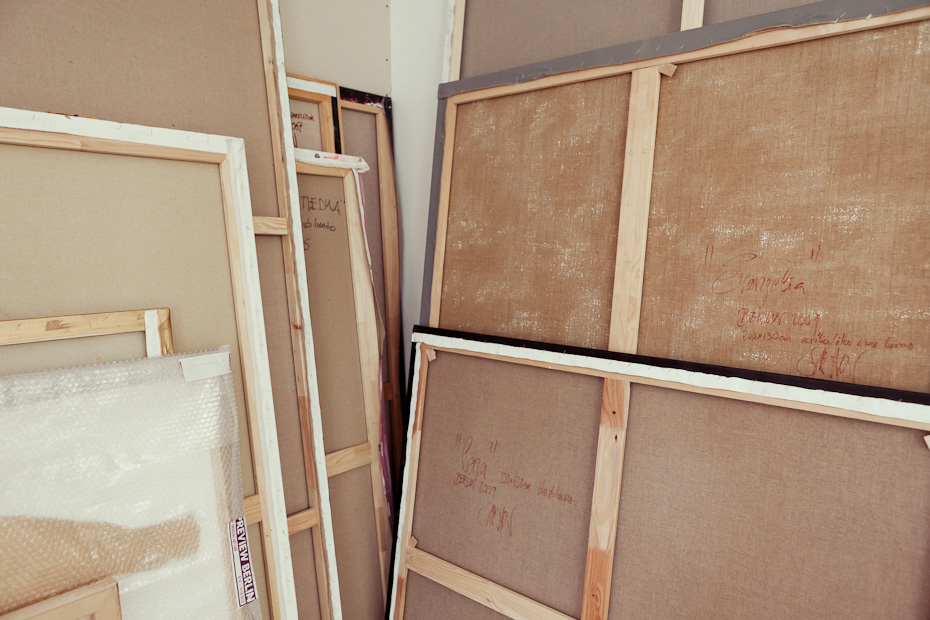Wedding’s cheap rents and high vacancy rates attract artists to work in the neighborhood. Yet the district remains rough despite several failed attempts by the city to establish it as the new Mitte. Therefore, when Antonio Santin invited us to visit his studio in Wedding, we pictured ourselves in an abandoned industrial surrounding. Instead we found ourselves inside a small, enchanted backyard, lined with Antonio’s huge canvases of young, stoic, women dressed in colorful robes.
After graduating from the Universidad Complutense de Madrid, Antonio came to Berlin and started painting portraits of men. Later he started one of his most haunting series, which displays young women laying on patterned carpets. While Antonio’s earlier works contain large sections of realism, his recent paintings are far more abstract. The most striking aspect of these paintings is their lack of distance and the uneasy feeling evoked in viewers as they confront the painting.
After spending a wonderful afternoon with Antonio in his atelier, he took us on a trip to the beautiful, hidden and under appreciated tracks of Wedding.




























How did you find this studio?
I was quite broke when I came to Berlin, so I started working for Architektur-Modelle-Berlin, here, in this backyard. I was making models for architects and sculptures for other artists. At a certain point I started my own production and this space became available. I moved in and used it as my studio and living space. Cutting down my cost of living was crucial for my survival as an artist. It allowed me to go on painting without having another job.
Did you have a classical art school education?
We had both contemporary and classical teachers. So I wouldn’t call it exactly a classical education. I did have a pair of great professors, but as an overall result I, like many others, ended up experiencing a severe creative blockade due to their contradicting approaches. The most important thing is that you take some time to find your own position, your own style and develop as an independent artist. It took some time for me to realize that.
You have been to the Hong Kong Art Fair lately. How did you experience the local art scene. Was it very different from Europe?
It is so cosmopolitan! Hong Kong was a great experience. I have been there only for a few days, so I can‘t really judge the market. But I experienced the market as very well going and energized. I had a solo presentation with several large- scale paintings and they were sold out very quickly, mainly to collectors in Asia. The overall feeling of the art exhibited in the fair was very sensual, very appealing, definitely a lot of premium art. No wonder that Art Basel is taking over.
How long have you been living here in Berlin?
For about six years now. But I was traveling a lot in between. I went to Barcelona for six months, as well as to Mexico and to New York. I always try to escape before the winter darkness shows up. But so far Berlin is the place where I am always coming back to.
What was your initial motivation for moving to Berlin?
Sometimes I think Berlin is like a bleached black hole, where everything good and bad catches and charms you. The reason why so many people decide to stay here is because the city allows you to be whatever you want to be. This can be a huge advantage or a drag. There are so many reasons why Berlin is an excellent breeding ground for a wide variety of emerging creativity. Even when you consider the city’s astonishing rapid gentrification in the last few years and of course the ego smog threat attached to every arty crowd, it still remains a great place to live.
Did you come to Berlin straight after you finished art school?
Yes. I spent one year at the Athens School of Fine Arts before I graduated in Madrid. After that I got the feeling that I had to change something. I came to Berlin in 2004.
You are also working in New York?
Yes, I am working together with Marc Straus gallery. I spent the last winter painting in a very nice studio in Brooklyn. I like the energizing effect of the city. So far the combination between being based in Berlin and then from time to time in New York offers me a great balance.
Do you think that your work reflects the different cities where you live?
I am sure, but I am not interested in finding out how it is reflected. Every new city offers me the possibility to get to know different people and circumstances while confronting me with its unique recurrent aesthetic patterns. Every new experience demands me to remain awake and attentive. For me this is like biographical coffee. But, apart from that, I think that I carry a lot of my inspiration inside.
Sometimes artists are scared that their own imagination gets blurred by looking at other artists’ works.
If one remains self-aware and honest, I think that his truth is what you can call “original”. When it is only about who ends up getting the final word, we easily forget what the whole conversation was about. I think the discipline of painting has finally become independent from the linear perspective of art history. Very few people care about the death and resurrection of painting styles and techniques. To a great extent painting has been released from the conceptual weight of art hysteria. All I expect from a painting, wherever it comes from and whenever it was made, is that it makes the world more desirable. Its all about soul, quality and commitment.
Was there anything you saw the last time that blew your mind?
Hmm. I saw that huge sculpture of Tara Donovan at Pace Gallery in New York. That work was really amazing. So sexy.
You focused on sculpture before you started painting?
Yes, I was focusing on sculpture at art school but the school wanted us to work on different fields of art. Therefore I was also educated in photographing, remaking, painting and so on.
Why did you change your medium from sculptures to large oil paintings?
I don’t consider this a real change. It is just that I have something to say and I express it. The message stays the same. After working as a fireman for ten years one day a man might decide that he wants to be a bullfighter. I assume that this man will never be a bullfighter but a fireman that fights bulls. The question if my sculptures survive in my paintings started to lose my interest. In fact it is all about tracking down the essence.
Tell me about your painting process. What happens between the first idea for a painting and the finished canvas?
Usually, the process involves a complete stranger. I wander around and when I find somebody interesting, I then ask the person whether he or she would like to be my model. There are completely different kinds of people who catch my attention. The only thing they have in common is that they have a certain look that I can transform into a painting, such as the series with girls lying on patterned carpets. When producing that series, I went to their apartments to have a look around and, when they allow me, I go through their wardrobe to select three or four dresses. I want to imply the person’s atmosphere in the image. After that I start the shooting so that I can use the image as a reference for the final painting. The fact that the photograph only serves as a reference is very important. I try to be very playful in the whole process of painting.
Do you try to create a personal connection to the people you paint or do you prefer maintaining a certain distance?
It’s so interesting to observe the process of a subject transforming into an object among other objects. Sometimes our belongings describe us more accurately than our statements. It is not about what we say but about what we end up acquiring. I adore my models. If I could, I would buy them.
Are you particularly interested in painting people?
I entered an Edgar Degas retrospective once. The room was crowded with very little children quietly sitting on the floor, listening to the teacher. The woman said: “Degas liked horses, and that’s why he painted horses, made sculptures of horses and took pictures of horses”. I think life is a lot easier when our expectations don’t ruin its exuberant beauty.
Do you draw more inspiration from silence or confusion?
I can’t really tell because you can’t differentiate the two. One day you are inspired by a shock and on another day you are inspired by meditation. I am a rather silent person with a confused mind.
Have you ever experienced a creative crisis?
Yes, of course. I did a lot of paintings during the last five years when I had to stick to many deadlines. I worked then day and night for a two or three month period. After that, I was tired. I needed a break. One can‘t continue painting continuously. Now, I try to stick to a daily working routine and work in a more balanced way. But in the end all crises are potentially creative. I suffer several every day, it is just part of my profession.
Where are most of your paintings going?
Most of them are going to private collectors but some of them are also in public collections. I think most of my paintings are in Paris and Zurich.
Where is your next exhibition?
I am currently working on my next solo show in New York with Marc Straus Gallery.
Have you ever thought about doing a solo show in Spain? Would that be important to you?
Well, yes it is very important for me. I would like to do it but it has to be the right moment. I am not in a hurry.
Do you think the role of art changes in times were everybody is over-stimulated by pictures in everyday life?
We are so overloaded with information it is insane! The language of painting is slow. Art demands time and space to be comprehended. I see so many things every day. There is only a minimal amount of really good art but this small amount makes it worthwhile! We need to look deeper and be selective in order to escape the mediocrity that surrounds us.
Have you always been sure about becoming an artist?
I made this decision rather late and went through a chaotic development process. I’d say the tendency was always there. The simple desire to work with my hands was an early intuition, but it would have been meaningless without the commitment of betting everything on it. Everything is a matter of commitment. Talent, as energy, is neither created nor destroyed; it either sublimates or frustrates us. In fact many people do have it, but just as important as having a talent is betting on it, not only one day but every day.
Your latest series contains no portraits whereas in your earlier series the face seems to be very important. Why is that?
It’s a natural evolution. I enjoy very much working with the human figure but it’s also my comfort zone. It was a challenging step getting rid of the figure, bringing the background to the front so drastically. I learned a lot with this series. However, the body is still there, under the carpet.
What makes a good cooperation for you? What are the important aspects when you work together with a gallery?
The main thing is that I can create an impenetrable bubble around the studio. My space of creativity has to be an intimate sacred place. Nobody asks you to do anything, and nobody really could, that’s the art vertigo, pouring a steady statement that mirrors your strengths and weaknesses. The artist’s life is a solitary struggle under the constant shadow of a fragile balance granted by the art market. Earning your living as an artist has never been a bed of roses, but nowadays it is definitely more accessible than it was. I feel privileged. For me the basic rule is pretty simple, I always try hard to do my best and I expect the same from my agent.
If you want to see more of Antonio’s paintings you should take a closer look at his website or visit his upcoming exhibition at Marc Straus Gallery in New York City.
Photography: Dan Zoubek
Interview: Antonia Märzhäuser & Ana Finel-Honigman
